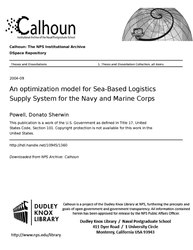File:An optimization model for Sea-Based Logistics Supply System for the Navy and Marine Corps (IA anoptimizationmo109451360).pdf

Original file (1,275 × 1,650 pixels, file size: 401 KB, MIME type: application/pdf, 58 pages)
Captions
Captions
Summary edit
| An optimization model for Sea-Based Logistics Supply System for the Navy and Marine Corps
( |
||
|---|---|---|
| Author |
Powell, Donato Sherwin |
|
| Title |
An optimization model for Sea-Based Logistics Supply System for the Navy and Marine Corps |
|
| Publisher |
This publication is a work of the U.S. Government as defined in Title 17, United States Code, Section 101. Copyright protection is not available for this work in the United States. |
|
| Description |
The United States is moving into a new era in which the enemy no longer provides symmetric opposition. The Navy and Marine Corps will face new challenges in the way they deploy and conduct future operations. One important way that these challenges will be met involves sea-based operations, which provide the sustainment necessary for prolonged operations and prevent unwanted operational pauses. Recent combat operations in Operation Iraqi Freedom (OIF) demonstrated difficulties when sustaining forces from logistics bases ashore. For example, advancing the Army and Marines to Baghdad in OIF consumed large amounts of fuel and ammunition. The resupply could not replenish supplies and an operational pause began on 29 March, 2003. In order to prevent operational pauses, rapid movement from the sea to the objective must be implemented. This thesis analyzes the problem of finding an optimal mix of Combat Logistics Force shuttle ships required to sustain the sea-base. This is accomplished through two optimization models: The first one determines a shuttle mix ensuring required inventory levels at the sea-base are maintained at all times. Since this requirement may cause some shuttles to be loaded partially, in the second model we manually assign the shuttle mix and then minimize unmet demand. This model yields a mix of shuttles that strikes a balance between shuttle cost and meeting sea-base demand. This thesis uses varying distances for conducting analyses over several scenarios. Subjects: Logistics, Naval; Military art and science; United States; Combat sustainability (Military science); Military supplies |
|
| Language | English | |
| Publication date | September 2004 | |
| Current location |
IA Collections: navalpostgraduateschoollibrary; fedlink |
|
| Accession number |
anoptimizationmo109451360 |
|
| Source | ||
| Permission (Reusing this file) |
Approved for public release, distribution unlimited | |
Licensing edit
| Public domainPublic domainfalsefalse |
This work is in the public domain in the United States because it is a work prepared by an officer or employee of the United States Government as part of that person’s official duties under the terms of Title 17, Chapter 1, Section 105 of the US Code.
Note: This only applies to original works of the Federal Government and not to the work of any individual U.S. state, territory, commonwealth, county, municipality, or any other subdivision. This template also does not apply to postage stamp designs published by the United States Postal Service since 1978. (See § 313.6(C)(1) of Compendium of U.S. Copyright Office Practices). It also does not apply to certain US coins; see The US Mint Terms of Use.
|
 | |
| This file has been identified as being free of known restrictions under copyright law, including all related and neighboring rights. | ||
https://creativecommons.org/publicdomain/mark/1.0/PDMCreative Commons Public Domain Mark 1.0falsefalse
File history
Click on a date/time to view the file as it appeared at that time.
| Date/Time | Thumbnail | Dimensions | User | Comment | |
|---|---|---|---|---|---|
| current | 15:18, 14 July 2020 |  | 1,275 × 1,650, 58 pages (401 KB) | Fæ (talk | contribs) | FEDLINK - United States Federal Collection anoptimizationmo109451360 (User talk:Fæ/IA books#Fork8) (batch 1993-2020 #7711) |
You cannot overwrite this file.
File usage on Commons
The following page uses this file:
Metadata
This file contains additional information such as Exif metadata which may have been added by the digital camera, scanner, or software program used to create or digitize it. If the file has been modified from its original state, some details such as the timestamp may not fully reflect those of the original file. The timestamp is only as accurate as the clock in the camera, and it may be completely wrong.
| Short title |
|
|---|---|
| Author | nmaniego |
| Software used | PScript5.dll Version 5.2 |
| File change date and time | 01:26, 27 September 2004 |
| Date and time of digitizing | 01:26, 27 September 2004 |
| Conversion program | Acrobat Distiller 6.0.1 (Windows) |
| Encrypted | no |
| Page size | 612 x 792 pts (letter) |
| Version of PDF format | 1.4 |

